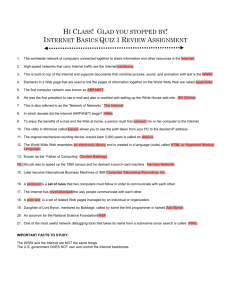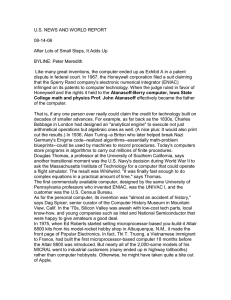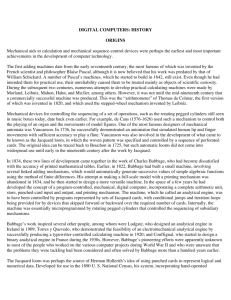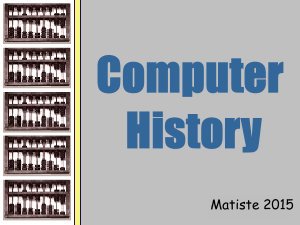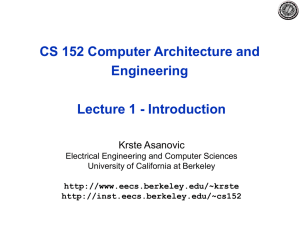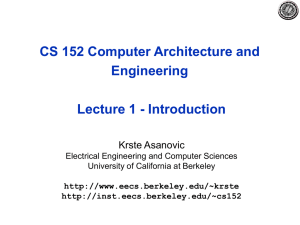History - American University Computing History Museum
advertisement
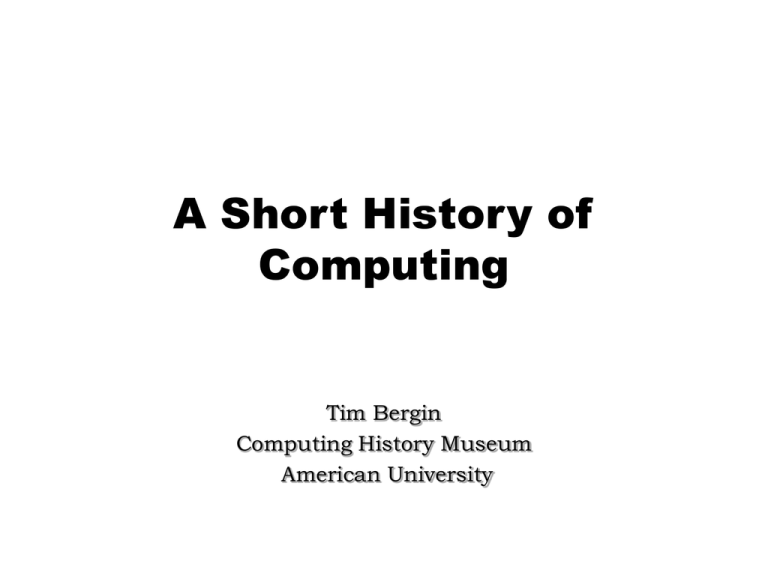
A Short History of Computing Tim Bergin Computing History Museum American University Ancient History Abacus • 3000 BCE, early form of beads on wires, used in China • From semitic abaq, meaning dust. Table Abacus 100,000 ------------------------------------50,000 --------------------------------------10,000 -------- --- ----------------------5,000 --------------------------------------1,000 ------------------------------------500 ----------------------------------------100 ---------------------------------50 -------- ------------------------------10 -----------------------------------------5 -----------------------------------------1 --------------------------------------- Chinese Swan Pan The Middle Ages Charles Babbage (1791-1871) Charles Babbage (1791-1871) • Born: December 26, 1791 • son of Benjamin Babbage a London banker (part of the emerging middle class: property, education, wealth, and status) • Trinity College, Cambridge [MA, 1817] with John Herschel and George Peacock, produced a translation of LaCroix’s calculus text. A vision of calculating by steam! My friend Herschel, calling upon me, brought with him the calculations of the computers, and we commenced the tedious process of verification. After a time many discrepancies occurred, and at one point these discordances were so numerous that I exclaimed, “I wish to God these calculations had been executed by steam.” 1821 Never to be completed • December 1830, a dispute with his chief engineer, Joseph Clement, over control of the project, ends work on the difference engine • Clement is allowed to keep all tools and drawings by English law Importance of the Difference Engine • 1. First attempt to devise a computing machine that was automatic in action and well adapted, by its printing mechanism, to a mathematical task of considerable importance. • 2. An example of government subsidization of innovation and technology development • 3. Spin offs to the machine-tool “industry” Science Museum’s Reconstruction • Difference Engine Number 2 (1847 to 1849) constructed according to Babbage’s original drawings (minor modifications) • 1991 Bicentenary Celebration • 4,000 parts • 7 feet high, 11 feet long, 18 inches deep • 500,000 pounds Science Museum Recreation 1991 (Doron Swade, Curator) Analytical Engine Ada Augusta Byron, 1815-1852 • born on 10 December 1815. • named after Byron's half sister, Augusta, who had been his mistress. • After Byron had left for the Continent with a parting shot -- 'When shall we three meet again?' -- Ada was brought up by her mother. Ada Augusta Byron, Countess of Lovelace • Translated Menebrea’s paper into English • Taylor’s: “The editorial notes are by the translator, the Countess of Lovelace.” • Footnotes enhance the text and provide examples of how the Analytical Engine could be used, i.e., how it would be programmed to solve problems! • Myth: “world’s first programmer” Herman Hollerith and the Evolution of Electronic Accounting Machines Herman Hollerith (1860-1929) Herman Hollerith • Born: February 29, 1860 – Civil War: 1861-1865 • • • • • • Columbia School of Mines (New York) 1879 hired at Census Office 1882 MIT faculty (T is for technology!) 1883 St. Louis (inventor) 1884 Patent Office (Wash, DC) 1885 “Expert and Solicitor of Patents” Census • Article I, Section 2: Representatives and direct Taxes shall be apportioned among the several states...according to their respective numbers...(and) every ...term of ten years • 1790: 1st US census • Population: 3,929,214 • Census Office Population Growth: • • • • 1790 4 million 1840 17 million 1870 40 million 1880 50 million fear of not being able to enumerate the census in the 10 intervening years • 1890 63 million Smithsonian Exhibit (old) Computing Tabulating Recording Company,(C-T-R) • 1911: Charles Flint – Computing Scale Company (Dayton, OH) – Tabulating Machine Company, and – International Time Recording Company (Binghamton, NY) • Thomas J. Watson (1874-1956) hired as first president • In1924, Watson renames CTR as International Business Machines Electronic Numerical Integrator and Computer • 1st large scale electronic digital computer • designed and constructed at the Moore School of Electrical Engineering of the University of Pennsylvania – since 1920s, faculty had worked with Aberdeen Proving Ground’s Ballistics Research Laboratory (BRL) Inspiration and Perspiration Unite • 1943 Mauchly and Eckert prepare a proposal for the US Army to build an Electronic Numerical Integrator – calculate a trajectory in 1 second • May 31, 1943 Construction of ENIAC starts • 1944 early thoughts on stored program computers by members of the ENIAC team • July 1944 two accumulators working Accumulator (28 vacuum tubes) ENIAC at Moore School, University of Pennsylvania Early Thoughts about Stored Program Computing • January 1944 Moore School team thinks of better ways to do things; leverages delay line memories from War research • September 1944 John von Neumann visits – Goldstine’s meeting at Aberdeen Train Station • October 1944 Army extends the ENIAC contract to include research on the EDVAC and the stored-program concept • Spring 1945 ENIAC working well • June 1945 First Draft of a Report on the EDVAC: Electronic Discrete Variable Automatic Computer First Draft Report (June 1945) • John von Neumann prepares (?) a report on the EDVAC which identifies how the machine could be programmed (unfinished very rough draft) – academic: publish for the good of science – engineers: patents, patents, patents • von Neumann never repudiates the myth that he wrote it; most members of the ENIAC team ontribute ideas British Efforts Manchester Mark I (1948) Manchester Mark I (1948) • Freddy Williams and Tom Kilburn • Developed an electrostatic memory • Prototype operational June 21, 1948 and machine to execute a stored program • Memory: 32 words of 32 bits each • Storage: single Williams tube (CRT) • Fully operational: October 1949 • Ferranti Mark I delivered in February 1951 EDSAC • Maurice Wilkes, University Mathematical Laboratory, Cambridge University • Moore School Lectures • Electronic Delay Storage Automatic Calculator, EDSAC operational May, 1949 • J. Lyons Company and the LEO, Lyons Electronic Office, operational fall 1951 National Physical Laboratory • • • • • • • Alan Turing Automatic Computing Engine (ACE) Basic design by spring, 1946 Harry Huskey joins project Pilot ACE working, May 10, 1950 English Electric: DEUCE, 1954 Full version of ACE at NPL, 1959 Alan Turing (1912-1954) • On Computable Numbers with an application to the Entscheidungsproblem • Code breaker Mainframe Computers John Mauchly leaning on the UNIVersal Automatic Computer Remington Rand UNIVAC • 43 UNIVACs were delivered to government and industry • Memory: mercury delay lines: 1000 words of 12 alphanumeric characters • Secondary storage: metal oxide tape • Access time: 222 microseconds (average) • Instruction set: 45 operation codes • Accumulators: 4 • Clock: 2.25 Mhz IBM 701 (Defense Calculator) • Addition time: 60 microseconds • Multiplication: 456 microseconds • Memory: 2048 (36 bit) words using Williams tubes • Secondary memory: – Magnetic drum: 8192 words – Magnetic tape: plastic • Delivered: December 1952: IBM World Headquarters (total of 19 installed) Second Generation (1958-1964) • 1958 Philco introduces TRANSAC S-2000 – first transistorized commercial machine • • • • IBM 7070, 7074 (1960), 7072(1961) 1959 IBM 7090, 7040 (1961), 7094 (1962) 1959 IBM 1401, 1410 (1960), 1440 (1962) FORTRAN, ALGOL, and COBOL are first standardized programming languages Third Generation (1964-1971) • April 1964 IBM announces the System/360 – solid logic technology (integrated circuits) – family of “compatible” computers • • • • 1964 Control Data delivers the CDC 6600 nanoseconds telecommunications BASIC, Beginners All-purpose Symbolic Instruction Code Fourth Generation (1971- ) • • • • • • Large scale integrated circuits (MSI, LSI) Nanoseconds and picoseconds Databases (large) Structured languages (Pascal) Structured techniques Business packages Digital Equipment Corporation (Mini-computers) Assabet Mills, Maynard, MA Flipchip PDP-8, first mass-produced Mini PDP-11 (1970) Microcomputers Intel • Noyce, Moore, and Andrew Grove leave Fairchild and found Intel in 1968 – focus on random access memory (RAM) chips • Question: if you can put transistors, capacitors, etc. on a chip, why couldn’t you put a central processor on a chip? • Ted Hoff designs the Intel 4004, the first microprocessor in 1969 – based on Digital’s PDP-8 Microcomputers • Ed Roberts founds Micro Instrumentation Telemetry Systems (MITS) in 1968 • Popular Electronics puts the MITS Altair on the cover in January 1975 [Intel 8080] • Les Solomon’s 12 year old daughter, Lauren, was a lover of Star Trek. He asked her what the name of the computer on the Enterprise was. She said “ ‘computer’ but why don’t you call it Altair because that is where they are going tonight!” Altair 8800 Computer Intel processors • • • • • • • • • CPU Year 4004 1971 8008 1972 8080 1974 8088 1980 80286 1982 80386 1985 80486 1989 Pentium1993 Data 4 8 8 8 16 32 32 64 Memory MIPS 1K 16K 64K 1M .33 1M 3 4G 11 4G 41 4G 111


